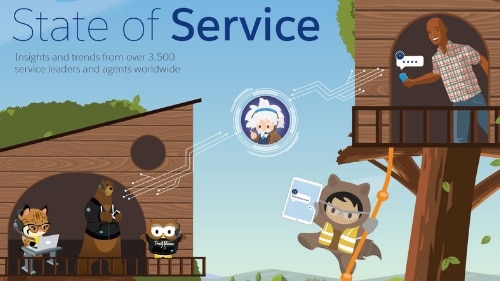Did you know many customer service departments are still in dinosaur mode? They face shifting demands from customers without the necessary tools, strategy, processes, and agents’ skills to meet them. When I speak at conferences, I often hear from customer service leaders about how difficult it is to make the necessary changes.
As Bill Patterson, Salesforce Service Cloud’s General Manager and Executive Vice President would say, “Never before has it been more important to rid the world of bad customer service experiences.” And the time has come to shift from customer service as a “necessary evil” to see it as a strategic asset.
The C-Suite sees customer service as a strategic asset
In fact, according to our recently released State of Service report, 82% of decision-makers say their company’s service must transform in order to stay competitive. Top performing companies agree transforming service is not just the right thing to do, but it makes bottom-line business sense. Eighty percent of customers now consider their experience with a company as important as its products. Bad experiences mean customers will vote with their feet, their browsers, and their hearts and switch to your competitors, without ever looking back.

When you think about it, it makes sense. Customer service is the most customer-facing ally a company has to drive loyalty. Top performers know if you lose your customer’s loyalty, you lose revenue, profits, and margins. In fact, . Brands that have transformed their digital customer experience generate more revenue and drive higher profitability.

The Fourth Industrial Revolution (4IR ) has transformed customer expectations of customer service
Eighty percent of service leaders say emerging technology is transforming their customers’ expectations of their service organization. Welcome to the Fourth Industrial Revolution. Customers ask Google Home to play their morning playlist, use applications to order their favorite coffee, call for a ride, or navigate traffic. What many people don’t realize is the reason these experiences are so sticky is that emerging technologies like AI embedded into these applications power the customer experience. That means to stay competitive, companies need to incorporate emerging technologies into their customer experience.
Customers now expect it to be as easy to do business with your company as it is to get product recommendations and order from Amazon. Top performing service leaders are now investing in 4IR technologies like AI and IoT. According to the report, 83% of top performers are not only getting the budgets needed to transform customer service operations, but 73% expect to get a budget increase next year to integrate new processes, technology, and changes to the agent’s role on the path to transforming service.
Customer service transformation is shaking up executive priorities
Because customers expect personalized, connected, and unified engagement from companies, top service leaders are focused on five major priorities:
- Improving their agents’ workforce skills. This means investing in training agents for the new world of work and technology. Want in on that? Check out the Trailhead Superbadge For Service Cloud.
- Evolving processes and workflows. This ensures agents have the right information, at the right time by improving the flow of information. This means automating workflows and having data, like billing and order management in their agent console.
- Upgrading from traditional, legacy channels of phone and email, to increase the use of advanced, customer engaging technologies like SMS, AI, and AI chatbots.
- Integrating service across the business. This means service, sales, and other departments can collaborate because their systems are connected. Now agents have access to the whole customer journey.
- Pivoting from a cost center to a profit center. Top performing companies are moving from transactional interactions to a customer relationship building engagement.

How customer service is transforming from a cost-center to a profit-center
Top service priorities are reflecting a change in how business gets done. Though it’s the fifth priority (see the chart above) pivoting from a cost-center to a profit-center is what will help the C-Suite take notice of the business contribution customer service can make. Transforming from a cost center to a profit center begins with the first priority, improving agent work skills. With enhanced work skills, service managers also have to transform how they reward agents so that the customer experience is better and they are able to retain customers. And because people focus on what they’re measured on, it means moving from metrics focused on reducing costs, (regardless of the effect on the customer experience) to profit-center metrics. This means while tried and true measurements like case volume and average handle time aren’t going away, top performers are now tracking performance metrics focused on the customer experience, including:

Takeaway
Customer service, once thought of as the “step-child” of most corporations is going through a transformation. And top performing companies aren’t waiting. They are well on their way to transforming not only their people and processes but also adopting new technologies. With customers’ attention span now shorter than ever, it’s essential that service leaders engage their C-suite and board of directors to allocate budgets and the resources necessary to transform how they deliver on the promise of being an organization of trusted advisors who drive customer loyalty.
To read upcoming trends and learn more about how executives are transforming customer service with a renewed sense of urgency in the fourth industrial revolution, download the report.




























